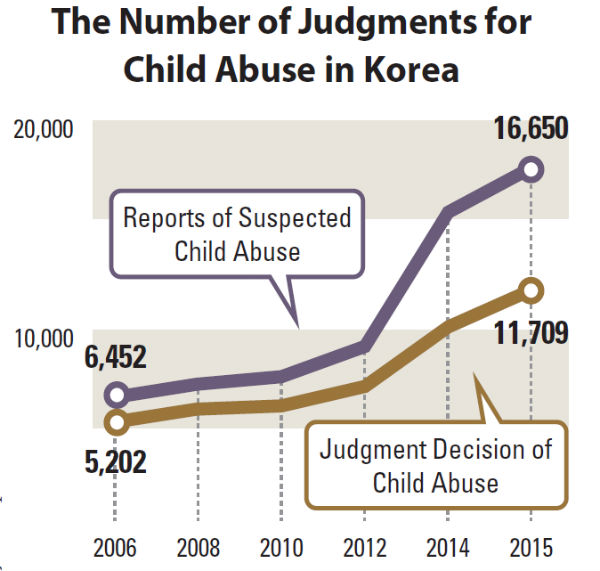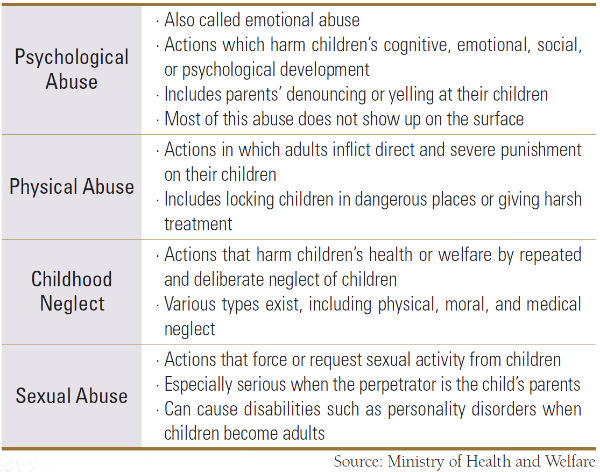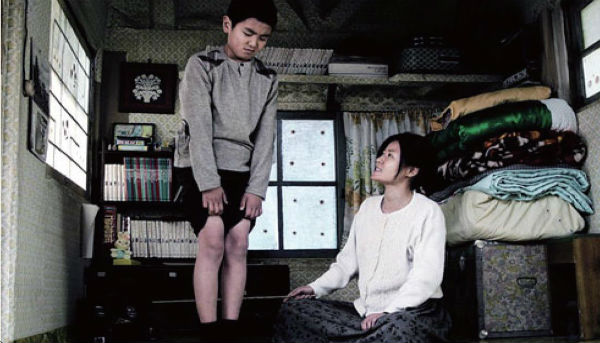The case of child abuse that resulted in the death of a seven-year-old child named Shin Won-young, which was reported earlier this year, shocked the Korean society. The abuse started in 2003, perpetrated by the victim’s stepmother who habitually abused and ultimately caused his death in February of this year. She tried to cover up the accident with her husband, but it was revealed by a town hall report. This kind of brutal child abuse does not disappear, and many children still suffer because of it. The Sungkyun Times (SKT) introduces the current situation of child abuse, problems of child abuse in Korea, and the efforts to solve this problem.
What is Child Abuse?
Status Quo of Child Abuse

According to the “Act on the Punishment of Child Abuse Crime,” the subject or victim of child abuse includes minors under the age of 18. In addition, child abuse occurs when adults perpetrate physical, sexual, or psychological assaults on children of these ages. This can happen within the family or in institutions such as schools. Among 19,000 cases of child abuse, 9,000 cases occurred within the family. A survey conducted by Seoul City also showed that close adults are the most prevalent perpetrators. In fact, 83 percent of perpetrators are the victim’s parents, and 10 percent are the victim’s caregivers, such as relatives or nursing school teachers. Reports of child abuse have constantly increased in Korea in recent days, and this number increased by 47 percent last year compared to the previous year. People started to become increasingly concerned about child abuse due to reports on cruel cases, and the need for preventive education has received significant attention.
Types of Child Abuse

Why is Child Abuse So Serious in Korea?
Cultural Factor
Korea has been largely influenced by Confucian culture and
patriarchy from the past. This shaped people’s thoughts to regard
children as a subject to be taught and nurtured by parents. In
other words, children did not deserve equal rights as independent
human beings. A survey by SBS News showed that people
believed hitting children as punishment for a bad grade was
abuse, but hitting children who stole other people’s belongings
was justifiable discipline. This statistic proves that hitting children
for discipline is still considered acceptable in Korea. In Western
culture where individualism has a greater emphasis, however,
the relationship between parents and children is more horizontal
and democratic. Therefore, parents and children have a strong
tendency to settle conflicts through communication, and parents
are more likely to respect their children’s opinions. This cultural
difference is one of the reasons contributing to the seriousness of
child abuse in Korea.

Social Factor
In Korea, although child abuse is practiced frequently, the
punishment for child abuse is insufficient, and the criminal
investigation process is not thorough enough. This is because
people believe some physical punishment is justifiable, and the
determination of legal penalties is decided by a standard sheet.
Because most judges tend to accept abuse to a certain degree as
discipline, the penalty can be minimized, as the standard sheet
gives judges the power to decide punishment from a minimum
term of two years and six months to a maximum of nine years.
Parents charged with child abuse often do not go to court, as 15
percent of them are not arrested, and most of them are suspended
of indictment. In addition, 70 percent of the allegedly abused
children were returned to their home even after detecting signs of
abuse, despite the fact that it is important to isolate children from
the perpetrator. This poor system increases the possibility of child
abuse, and people are now pressuring the government to enact
a law to improve the system. Recent investigations, however,
disclosed the fact that almost 30 laws were not passed by the end
of the 19th National Assembly.
What Are the Problems of Child Abuse?
Deprivation of Children’s Rights
“The Convention on the Right of the Child” defines four
representative rights of each child. First is the right to survive,
for which a comfortable residence, a proper standard of living,
and their life should be guaranteed. Second is the right to be
protected, which requires protecting children from discrimination
and abuse. Third is the right to development, which is aimed
to provide all types of education and freedom to children. Last
is the right to participate, which secures the freedom of a child
to express his or her own views without limitations. Most cases
of child abuse violate all four of these rights, since they occur in
complex ways. Thus, it is a serious social problem because adults
are depriving children of their rights by using their advantageous
and stronger position.
Irreparable Harms to Children
In the last five years, from 2010 to 2014, 68 children lost their
lives due to child abuse in Korea. This shows that child abuse
causes harm beyond physical injuries. Mental trauma is a serious
problem, but it has various types and is not easily revealed on
the outside. According to research conducted by Roe-Sepowitz,
victims of child abuse have a strong tendency to blame themselves
and behave in a helpless, passive way due to the lack of
developing attachment. Victim children, especially those abused
by their parents, suffer from more severe mental issues, since they
tend to believe that the reason for the abuse exists within them.
In fact, 21 percent of victim children in Korea considered suicide,
and this frequently led to actual attempts. They feel anxiety with
personal relations throughout their lives because they cannot
easily erase the bitter memories of their childhood.
Extension to Social Violence
Child abuse statistics reveal that children who experience child
abuse are 59 percent more likely to commit a crime in their
adolescence and 28 percent more likely to do so in adulthood.
In addition, parents who experience abuse in their childhood
have a higher likelihood of abusing their own children. This
is because repeated violence causes them to perceive violence
as a method of conflict resolution. They also have different
brain structures. As an example, the cerebral cortex, which is
in charge of the senses, and hippocampus, which controls the
senses, are relatively smaller than those of other people who did
not go through the abusive experience. This makes adults with
memories of abuse become more antisocial and causes impulse
control disorders. Therefore, child abuse can lead to social
crime, and the government must spend a large amount of money
to deal with the fallout.
How to Fight Child Abuse
Strengthening the Recognition of Child Abuse
Most Koreans do not recognize psychological abuse as child abuse
because they are familiar with the authority of parents and still
regard physical punishment as ordinary discipline. Moreover,
Korea’s percentage of child abuse reports is 29 percent, which is a
markedly low figure compared to Japan’s 63 percent or the United
States’ 60 percent. It is necessary to urge people to quickly report
signs of abuse, as most victim children are not rescued in spite of
exposure to outside members of society. Most people who have an
obligation to report, such as teachers, people who work for childrelated
institutions, and medical teams, however, are not aware of
their responsibility. For these reasons, it is important to strengthen
the recognition of child abuse through education or media.

Recently, Samsung SDS installed an advertisement for child abuse
prevention at Gwanghwamun Square. They projected a picture
of an adult abusing a child on a large screen. When people stand
in front of the screen, they can complete the picture where they
protect the child and see the message that reads, “Please be a hero
of children through a report call.” This advertisement contributed
to strengthening the recognition of child abuse by drawing the
interest of people and encouraging their participation.

Busan also printed and distributed a new type of poster for child
abuse prevention. It uses a technology called “Lenticular” that
shows different images depending on angles. The next picture on
the left is shown to adults who see from higher eye-levels, and
the picture on the right is shown to children who see from lower
eye-levels. The left one reads, “There are many abused children
around us.” The other poster reads, “Call us whenever someone
hits or abuses you.” Busan came up with the idea from a child
protection organization in Spain called the “ANAR Foundation.”
The foundation first made the same kind of advertisement to
encourage people to donate, and this advertisement reached nine
million views on YouTube. The poster made by Busan City also
attracted people’s interest through the new method that the ANAR
Foundation introduced.
Improving Laws and Systems Related to Child Abuse
There are many other countries where perpetrators of child abuse
were found guilty of murder, which is a situation that does not
happen in Korea. For instance, the United Kingdom (UK) sentenced
life imprisonment to an old woman who killed an eight-year-old
boy in 2000, and Germany also sentenced life imprisonment to a
stepfather who hit his stepdaughter’s face in 2007. Moreover, the
UK enacted a law known as the “Cinderella Law,” which gives a
maximum of a ten-year-sentence for psychological abuse. Although
Korea tried to enforce punishment by legislating laws such as the
“Special Act for the Punishment of Child Abuse,” the budget for
child institutions is inadequate to achieve any widespread impact.
Korea’s child-related facilities have poor conditions, and this makes
it hard to secure a sufficient workforce. For example, people who
work for child-related institutions were paid ₩20 million as
their annual income, while other welfare workers were paid ₩40
million. Therefore, the government has to arrange a larger budget
in order to bolster child-related infrastructure.
Although the government has attempted to pass laws and improve systems to prevent
and resolve Korea’s child abuse problem, some limitations and problems persist. An
Anti-Abuse Police Officer who deals with child abuse said that most child abuse was
discovered by neighbors who detected and reported strange circumstances. The case
of Shin Won-Young also became known to people by the report of the Pyeongtaek-eup
Community Service Center. This demonstrates that people’s continuous concern and
attention for detecting child abuse should exist along with the government’s endeavors.
